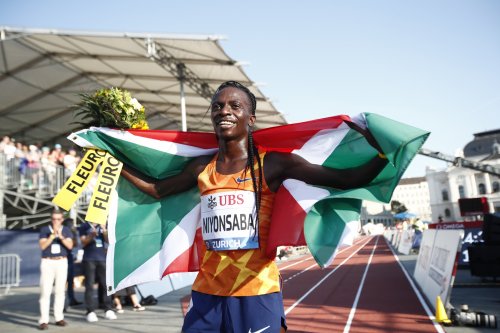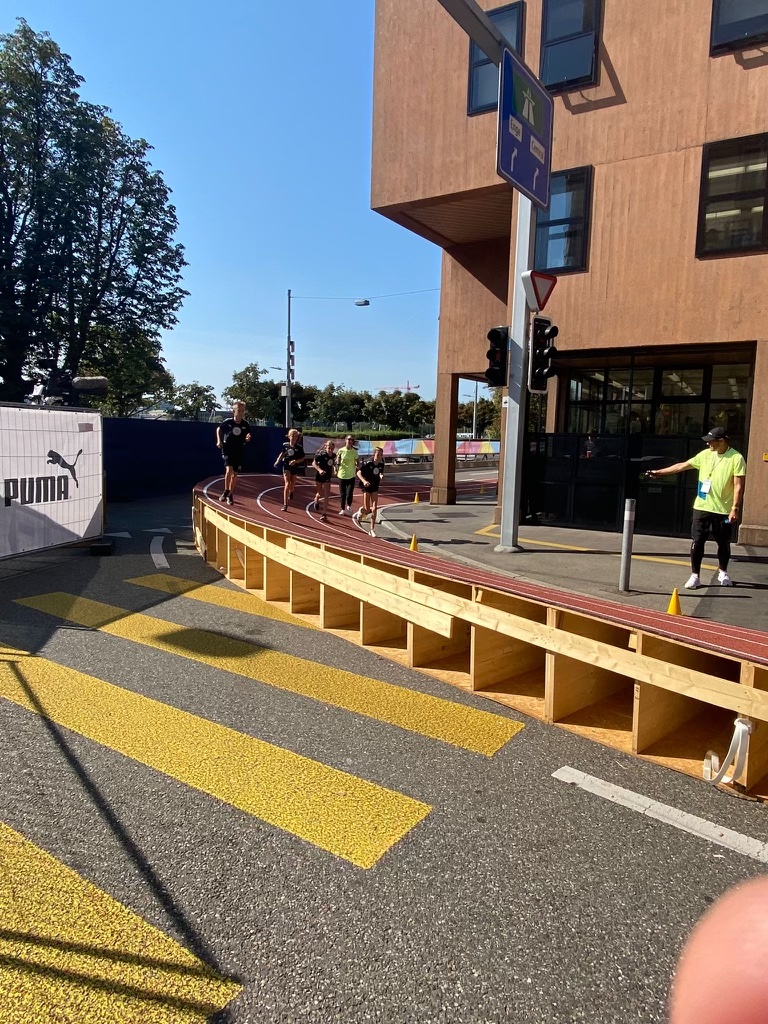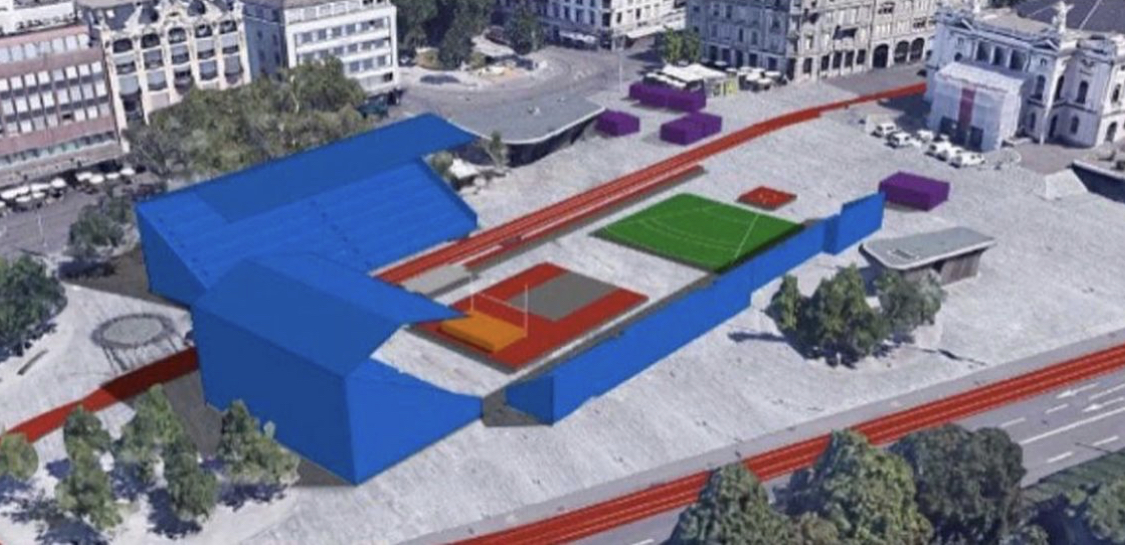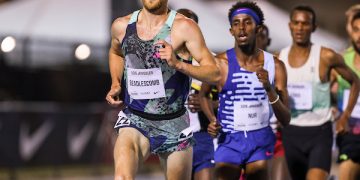Matt Wisner wrote for us at the Olympic Trials and the Olympics. This is his first column on his new weekly column, From Lane One. Matt Wisner came to us via an introduction by Lori Schontz, the University of Oregon professor who is championing sports journalism, particularly, track & field journalism at the Univeristy of Oregon and environs.
We think that you will enjoy Matt’s obvious affection for the sport, and his ability to use critical thinking in his journalistic coverage of the sport of global athletics. He is not, as one can see, a fan of the 563 meter track built just to bring track to the fans.
This column is on the Zurich Diamond League and their day one. They built, at much expense, an unusual track at the Lakeside in Zurich, which was a unique distance of 563 meters around.
 Francine Niyonsaba, Zurich DL by the Lakeside, photo by Diamond League AG
Francine Niyonsaba, Zurich DL by the Lakeside, photo by Diamond League AG
From Lane One (#1)
Bringing Track to the People: Zurich Diamond League Final 5,000s Were Held On a Bizarre Street Track
9/9/2021
By Matt Wisner
The Diamond League Final in Zurich featured 32 events over two days. The seven events that were held on the first day happened on Sechseläutenplatz, which is one of Zurich’s busiest and most famous city blocks. The meet organizers set up temporary shot put rings, high jump pits, and long jump pits–all standard specifications for competition. All of them seemed to work.
What didn’t seem to work, though, was the unconventional 563-meter temporary track constructed for the 5,000 meter races. It wasn’t the standard oval shape. One end of the track had a really tight turn (which appears tighter than a standard indoor track), and banks were constructed to compensate for the bizarre turnaround.

Photo credit: Rolf Folmli
Olympic champions Jakob Ingebrigtsen and Selemon Barega both pulled out of the 5,000 when they arrived in Zurich and saw the track before the meet. Paul Chilemo, the top American this year, also made it very clear that he isn’t a fan of the street track; he took issue with the fact that his times wouldn’t count toward any records.
Jakob’s father, Gjert Ingebrigtsen, spoke to the media about the decision for his son to scratch from the 5,000. “It didn’t look like this on the overview map–that the turn was so abrupt,” Gjert Ingebrigtsen says. “You have to run out a bit and do a Formula 1-style track. If people come from the outside and the inside, then there will be collisions in the curve and there will be a lot of chaos.”

Virtual image of the proposed layout of the track on Sechseläutenplatz in Zurich.
I guess the logic is that if the people won’t come to the track, bring the track to the people. But it only kind of works here. People still have to buy a ticket to the street track events. And the stands, which sat 2,500 people, mostly blocked the views of normal people walking the streets in Zurich. It’s also important to note that the stadium, which held all of the events on the second day, was not full, and the street track may have been a last-ditch effort to boost ticket sales.
There are more problems with the street track. The people in the stands could only see a fraction of the race. The weird 563 meter distance made it difficult for athletes to be aware of their splits. It also made it difficult for hardcore fans following along on television.
I’m sympathetic to the attempt. But I think it was frivolous. The sport certainly needs to experiment with fresh and innovative ways of attracting new fans, and holding a meet on a temporary track in the middle of a crowded city may be one of those experiments. But this is the Diamond League Final. There are serious stakes: The winner gets $30,000 and an automatic bid to the World Championships next year in Eugene. Any kind of non-standard competition in such a serious meet seems careless.
Regardless, the two 5,000 races were held, and they were both entertaining. Francine Niyonsaba of Burundi won the women’s race in 14:28.98, less than a second faster than Hellen Obiri who finished second in 14:29.68. Those are fast times considering how the sharp turns should have probably slowed the athletes down.
Niyonsaba, though, was not disconcerted by the unconventional setup. “We love to see the people around here, cheering for us,” she says. “This race was amazing. I love challenges.”
Niyonsaba has won her past four Diamond League appearances (after a controversial disqualification in Tokyo). She usually only makes the pass at the very end of the race, but in Zurich, she took over at the bell and held off Obiri for the full final lap.
Niyonsaba is relatively new to the distance events; even just a few years ago, she was an 800-meter specialist, only racing in the longer distance events because of World Athletics’s rule that restricted her from competing in events from 400-meters up to the mile because of her elevated testosterone from being intersex. Niyonsaba’s future is unclear: Next year, she could be the best distance runner in the world, or she could be barred from competing.
“I am still learning after switching from the 800 to longer distances,” Niyonsaba says. “I did what I had to do.”
Berihu Aregawi of Ethiopia won the men’s 5,000 in 12:58.65. First of all, that’s fast for this weird track. Aregawi made a huge move over the final two laps and won by nearly three seconds over Bahrain’s Birhanu Balew who finished second in 13:01.27.
“I did not expect such a fast time,” Aregawi says. “The venue in the city is good. Yet, the curves were a bit difficult for me.”
We’ll see both Niyonsaba and Aregawi in Eugene next year. And the beautiful Hayward Field will ensure that no silly street track stunts will be orchestrated in Eugene.
Author

Larry Eder has had a 52-year involvement in the sport of athletics. Larry has experienced the sport as an athlete, coach, magazine publisher, and now, journalist and blogger. His first article, on Don Bowden, America's first sub-4 minute miler, was published in RW in 1983. Larry has published several magazines on athletics, from American Athletics to the U.S. version of Spikes magazine. He currently manages the content and marketing development of the RunningNetwork, The Shoe Addicts, and RunBlogRun. Of RunBlogRun, his daily pilgrimage with the sport, Larry says: "I have to admit, I love traveling to far away meets, writing about the sport I love, and the athletes I respect, for my readers at runblogrun.com, the most of anything I have ever done, except, maybe running itself." Also does some updates for BBC Sports at key events, which he truly enjoys. Theme song: Greg Allman, " I'm no Angel."
View all posts




















